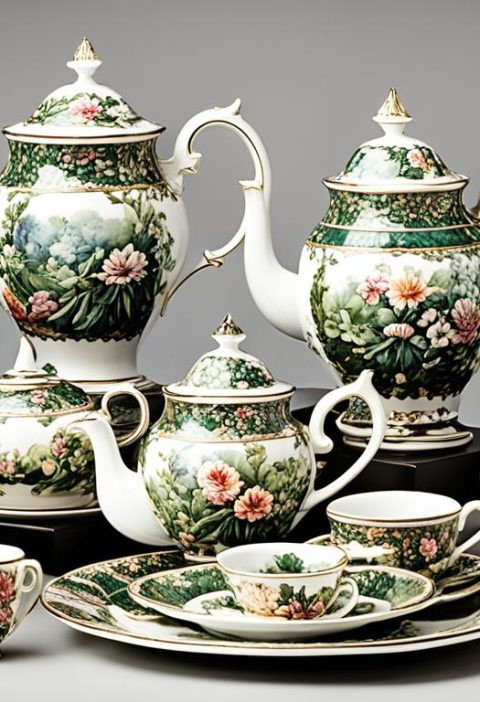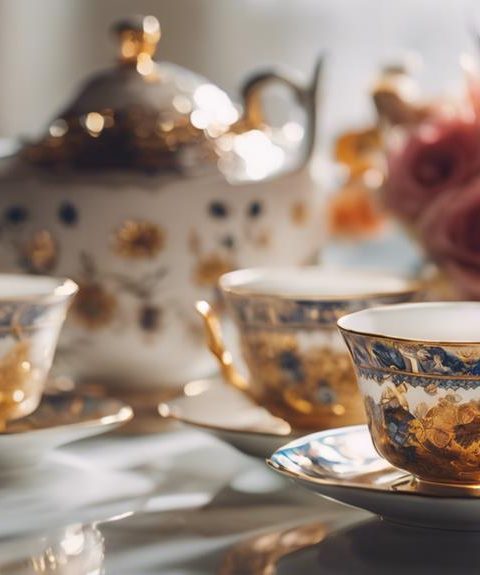Exploring Moroccan Tea Sets is a delightful journey into the world of Mint Tea. As an avid tea enthusiast, I’ve uncovered the intricate artistry behind these exquisite tea sets.
With years of experience in discovering unique tea cultures, I invite you to join me on this aromatic adventure. Together, we’ll delve into the rich history and traditions that make Moroccan Mint Tea a cherished beverage worldwide.
Discover the secrets of brewing the perfect cup of mint tea, learn about the symbolism of each element in a traditional Moroccan tea set, and immerse yourself in the cultural significance of this time-honored ritual. Join me as we sip our way through the enchanting world of Moroccan Tea Sets.
The History of Moroccan Tea Sets
The Origins of Moroccan Mint Tea
Moroccan Mint Tea, also known as “Atai,” has a long and storied history dating back centuries in Morocco. Traditionally, this tea is made using green tea leaves, fresh mint leaves, sugar, and boiling water. The combination of these ingredients creates a refreshing and aromatic beverage that is not only enjoyed daily but also holds cultural significance in Moroccan hospitality rituals.
Evolution of Tea Set Designs
The evolution of Moroccan tea sets reflects the intricate blend of art, culture, and history in Morocco. These tea sets, characterized by their vibrant colors, intricate patterns, and metallic embellishments, have evolved over time to incorporate modern influences while maintaining their traditional essence. From the traditional handcrafted ceramic tea sets to modern interpretations featuring contemporary designs, Moroccan tea sets continue to captivate with their timeless elegance and cultural symbolism.
Cultural Significance of Mint Tea in Morocco
Exploring the cultural significance of mint tea in Morocco unveils a tapestry of rituals and traditions deeply woven into the fabric of Moroccan daily life. From bustling markets to serene homes, the aroma of brewing mint tea permeates every corner, symbolizing hospitality, friendship, and generosity.
Rituals and Traditions
In Moroccan culture, mint tea isn’t just a beverage; it’s a symbol of hospitality and a cornerstone of social gatherings. When welcoming guests into their homes, Moroccans often perform a traditional tea ceremony, pouring the tea from a height to create froth, a gesture of respect and warmth. This ritual signifies the importance of connection and community, where sharing a cup of mint tea fosters bonds and meaningful conversations.
Tea Set’s Role in Moroccan Hospitality
Central to the art of mint tea brewing is the Moroccan tea set, a masterpiece of craftsmanship and tradition. Adorned with intricate designs and vibrant colors, these tea sets elevate the tea-drinking experience, turning a simple act into a sensory delight. The tea pot, glasses, and tray harmonize to create a visual symphony that mirrors the elegance and warmth of Moroccan hospitality. Serving mint tea in these exquisite sets embodies the spirit of generosity and care, inviting guests to partake in a cherished Moroccan tradition.
Components of a Traditional Moroccan Tea Set
The Tea Glasses: A Blend of Beauty and Function
In a traditional Moroccan tea set, the tea glasses play a vital role as they combine intricate beauty with practical functionality. These glasses, often ornately decorated with colorful patterns and designs, are typically small in size to contain the strong mint tea. They are crafted to preserve the heat of the tea, allowing the drinker to enjoy each sip at the perfect temperature.
The Teapot: Crafting Elegance in Silver and Brass
The teapot in a Moroccan tea set is a symbol of elegance and craftsmanship, usually made of silver or brass. With its curved spout and decorative motifs, the teapot is designed to pour the tea gracefully into the glasses. Its sturdy construction helps retain the heat, ensuring that the tea remains warm throughout the serving process.
Serving Trays and Accessories
Serving trays and accessories are essential components of a traditional Moroccan tea set, adding a touch of sophistication to the tea-drinking experience. The trays are often adorned with traditional engravings and are used to carry the tea glasses and teapot. Additionally, sugar bowls, mint leaves, and decorative elements like silver or gold sugar tongs complement the set, enhancing the overall presentation and enjoyment of the tea ceremony.
Artisan Craftsmanship Behind Moroccan Tea Sets
Intricacy and tradition define the artisan craftsmanship behind Moroccan tea sets, with techniques honed and passed down through generations.
Techniques Passed Down Through Generations
The art of crafting Moroccan tea sets is a heritage skill preserved and perfected over centuries, intricately weaving together mastery and cultural significance.
Regional Variations and Influences
Across Morocco, diverse regional influences infuse distinct characteristics into tea set designs, reflecting the unique heritage and traditions of each area.
Selecting the Perfect Moroccan Tea Set
When choosing a Moroccan tea set, there are essential aspects to consider to ensure an authentic and enjoyable tea-drinking experience. Here are some valuable tips to guide you in selecting the perfect Moroccan tea set.
Tips for Identifying Authenticity
- Material Quality: Look for tea sets made from authentic materials like brass, silver, or ceramic, as these are commonly used in traditional Moroccan tea sets.
- Artisan Craftsmanship: Authentic Moroccan tea sets are often handcrafted by skilled artisans, showcasing intricate designs and patterns that reflect the rich cultural heritage of Morocco.
- Traditional Design Elements: Pay attention to traditional Moroccan design elements such as geometric patterns, floral motifs, and vibrant colors, which are characteristic of genuine Moroccan tea sets.
Caring for Your Moroccan Tea Set
To maintain the beauty and functionality of your Moroccan tea set, it is essential to follow proper care practices. Here are some tips for taking care of your Moroccan tea set:
- Handwashing: Always wash your tea set by hand using mild soap and warm water to prevent any damage to the delicate designs and materials.
- Avoid Abrasive Cleaners: Refrain from using harsh or abrasive cleaners that can scratch or tarnish the surfaces of your tea set.
- Dry Thoroughly: After washing, make sure to thoroughly dry each piece of the tea set to prevent water spots and maintain its shine.
By following these tips for selecting an authentic Moroccan tea set and caring for it properly, you can enhance your tea-drinking experience and enjoy the beauty and culture that these sets bring to your tea rituals.
Key Takeaways
- Moroccan Mint Tea, or “Atai,” has a rich history in Morocco and is a symbol of hospitality and cultural tradition.
- Moroccan tea sets showcase a blend of intricate artistry, vibrant colors, and traditional designs that evolve with modern influences while maintaining their essence.
- Mint tea brewing is a ritual in Moroccan culture, symbolizing warmth, connection, and community, with the tea set playing a central role in enhancing hospitality.
- Traditional Moroccan tea sets consist of tea glasses, teapots, serving trays, and accessories crafted with beauty and functionality to elevate the tea-drinking experience.
- The craftsmanship behind Moroccan tea sets reflects generations of skill and cultural significance, honoring regional variations and influences.
- Selecting an authentic Moroccan tea set involves considering material quality, artisan craftsmanship, and traditional design elements to enhance the enjoyment of the tea-drinking experience.
Conclusion
Exploring Moroccan Tea Sets has been a fascinating journey into the world of mint tea. From the intricate designs to the cultural significance, these tea sets embody art, history, and tradition. Selecting an authentic Moroccan tea set involves considering material quality, craftsmanship, and design elements. Caring for these sets ensures their longevity and beauty. By incorporating these sets into our tea-drinking rituals, we embrace the rich cultural heritage of Morocco. Cheers to enjoying the artistry and elegance of Moroccan tea sets in every sip of mint tea.





